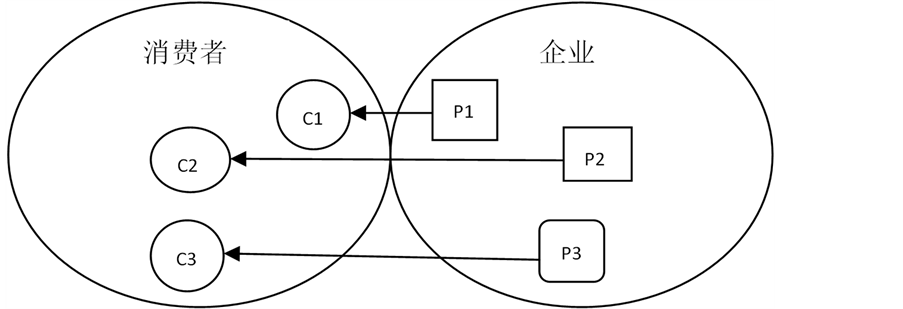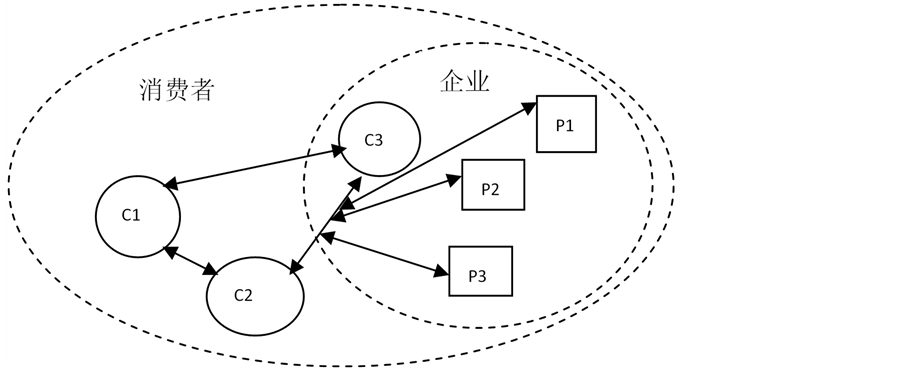1. 引言
价值共同创造包括两个部分,首先是“价值创造”,将价值通过生产过程附加于产品和服务之上,并以价格的形式实现交换关系。第二个构成是“共同生产”,价值网络中的消费者和企业或其它消费者合作,对产品和服务进行共同设计或共同生产。作者通过文献研究发现,价值共创包括生产领域的价值共创(如供应链和价值链理论所解释的企业间价值共创行为)和消费领域的价值共创(消费者参与的价值共创行为)。消费领域的价值共创是今天值得重点探讨的“价值共创”主题,因为当消费者消费产品或服务时,顾客价值才会出现(Holbrook, 2006) [1] 。
2. 消费者从交换关系中的被动接受者变成了主动参与者和价值共创者
互联网时代,消费者不纯粹是被动接受产品和服务的顾客角色,越来越多消费者也正在转变为企业行为的参与者。出现了很多的概念描述这种新型的消费者角色,如产消者(Prosumer)、众包(Crowd Sourcing)、顾客参与(Customer Involvement)和价值共同创造(Value Co-creation)等来自于不同学科领域的相关概念。
Toffler (1980) [2] 最早提出术语“产消者”来表示消费者参与到服务的消费和生产中的特殊作用,“顾客不仅贡献钱,还有市场和设计好的信息,对生产过程很重要”。Kelly (1999) [3] 指出最好的产销理念(Prosumerism)的应用就是“在线”。普拉哈拉德和拉马斯瓦米(2005) [4] 指出,随着商业环境和网络的发展,消费者越来越多地与产品和服务的供应商进行积极明确的对话。消费者信息获取更加便利,可以从世界各地获取信息,通过网络建立各种“主题社区”,通过互联网进行试验和开发产品。消费者既可以自己学习,也可以通过其他消费者的共同知识来了解商业活动。消费者不仅可以主动发起对话,而且已经从当观众走上了表演的舞台,消费者的角色发生了很大的演进和转化。“产消者”所实施的生产方式也是一种独特的“大众生产”方式(Peer Production) (Benkler, 2006) [5] ,也被称为“众包”(Crowd Sourcing) (豪,2011) [6] ,把传统上由内部员工或外部承包商所做的工作外包给一个大型的、没有清晰界限的群体去做。消费者参与不仅为企业提供了产品、服务重新设计的观点和测试,而且更有利于企业接近消费者并营造互动愉悦的服务体验。
自从Vargo和Lusch (2004) [7] 提出服务主导逻辑理论以来,消费者就被视为价值共同创造者,学者们关注消费者在价值共创过程中的角色和作用。服务的“共同创造”指消费者和服务专业人士联合生产服务,“共同创造”直接引导消费者参与价值的生产和分配,允许消费者参与到价值链中的任何一个环节,从而创造了动态的企业—消费者关系。国内有些学者也开始重视对“共同创造”理论的研究,如对外经济贸易大学王永贵教授2010 年主持的国家自然科学基金项目,题目即为“基于服务主导逻辑范式的价值共创与分享研究:理论探讨与实证分析”,复旦大学的范秀成教授、武汉大学的汪涛教授等也开展了一些相关研究。但至今为止,服务主导逻辑对消费者如何参与价值联合创造的研究依然非常有限,甚至很少有关于管理联合创造过程框架的研究。研究主要采用的是企业视角,聚焦于企业与消费者间的互动行为及服务绩效研究(汪涛等,2009;范秀成和张彤宇,2004) [8] [9] 。
消费者参与价值共同创造,体现在消费者与其它利益相关者共同合作的关系网络中。由于消费领域的价值共创形式呈现多样化,该领域的研究将是当前和未来一段时间的前沿问题。在价值创造方面,作者认为价值就是指顾客价值,其具有主观性、动态性、差异性,和个体的需要动机密切相关;顾客价值与消费者满足程度相关,产品或服务只是满足手段之一,还有其他需要发现归纳的方式;顾客价值不只发生于消费者和企业间,也存在于自发自愿、互动合作的消费者之间。但现有研究主要是从企业视角来探究价值共创系统设计及其绩效提升等主题,管理视野常聚焦于企业顾客互动界面,消费者-企业之间的价值创造只是一种价值共创模式,目前的研究忽视了对消费者单独创造价值以及消费者间互动创造价值的研究,而这两种价值创造形式是互联网经济研究中的弱点和难点。另外,价值共创中对消费者需要动机的关注较少,也忽视了价值共创和商业模式创新的关系,更缺乏理论化模型和系统性研究。
3. 消费者不同的需要层次和满足方式是价值共创的驱动力
1、新经济社会学的“镶嵌观点”
在人性假说和经济学建构方面,我们常常以亚当·斯密的经济人假说为依据,分析经济现象和消费行为,于是我们一直想当然认为每个消费者在购买过程中都在追求最多的效用和最低的费用。新制度经济学也认为,商业组织被认为在任何情况下都以最有效率地处理经济交易为原则。在社会学领域有两种流派,一种流派坚持认为经济行为和社会化没什么关联,消费者是理性人和经济人,这个流派被冠以“低度社会化”的称呼。另外一个流派,则认为人是“过度社会化”的,社会对人是有很大影响的。
然而,新经济社会学者格兰诺维特(Granvotter, 1985) [10] 发表了一篇题目为《经济行动与社会结构:镶嵌问题》的论文,指出商业关系与社会关系密不可分,人们具有目的性的行动企图实际上是镶嵌在真实的、正在运作的社会关系系统之中的,强调“镶嵌观点”:行为和制度深深受到社会关系的限制,反对低度社会化和过度社会化。他试图用镶嵌观点质疑威廉姆森的“市场抑或科层”中的观点,并用来解释这样一个议题:在现代社会中哪些交易由市场负责,哪些交易则留在科层组织内。
2、马斯洛的Z理论
既然如此,关于人的需要研究就不该只停留在经济人假说上。心理学家马斯洛在1954年出版的个人著作《动机与人格》提出需求五层次理论 [11] ,是解释人格和动机的重要理论。马斯洛提出人体成长的内在动力是动机,而动机由多种不同层次与性质的需求所组成,前四种是缺失性的需要。缺失性需要起源于实际的或感知到的环境或自我的缺乏,个体会努力从环境中寻求能使其需要得以满足的东西,无论是从物质上的,人际关系的还是社会地位的,这些需要的满足完全依赖于外界。而第五种自我实现则是成长性的,成长是导致自我实现的种种过程,成长性动机就是被自我实现的趋向所激发的动机,这种需要靠自我行动和体验去实现。1959年以后,他反思已经创建的人性观,发现人类天性中还有一种固有的精神维度,那就是作为最高层次的精神的自我实现或超越的自我实现。于是马斯洛在人本心理学的基础上,又提出了更高阶段的心理学——超人本心理学(Trans-humanistic psychology)。马斯洛在1969年发表了新观点——Z理论(Theory Z) (李安德,1994) [12] ,提出增加第六个需求层次,见图1。马斯洛说“超个人心理学是以宇宙为中心,而不只注意人性需求或兴趣而已,它超越人性、自我及自我实现等观念”。我们需要“比我们更大的”东西,激发出敬畏之情,重新以一种自然主义的,经验性的、与教会无关的方式奉献自己。”马斯洛用不同的字眼来描述新加的最高需求,例如灵性、超越自我、神秘的、超人本(不再以人类为中心,而以宇宙为中心)、天人合一、高峰体验、高原体验等等。基于这种需求层次的管理就要考虑到超个人的价值、存在价值或宇宙价值的激励作用,假设人是具有为更大的目标而献身的需要和自我牺牲的精神,Z理论可以解释今天的网络用户利他和分享的行为。
根据Z理论,前面的四种人性需要(生理需求、安全需求、社会需求、尊重需求)都可以借助购买商品和服务而实现,如购买生活用品是满足了低层次的生理需求,而购买奢侈品则满足了社会和尊重需求。高层次的需求(自我实现的需求、自我超越的需求)则很难通过购买商品和服务来满足,而是需要身体力行的行动和体验。于是消费者的参与、创造、分享、利他等都是这两种需求得以满足的行动方式,可以解释互联网上新型的社群组织和商业现象。如博客、QQ空间等的崛起,就满足了个人记录生活和创造个人价值的需要,他们这种行为完全属于自娱自乐自助的价值创造方式,只是满足第五层次需求“自我实现”的需要,也属于消费者独立创造价值的方式。而开源运动则解释了个体第六层次“自我超越的需求”的满足和实现方式,即追求高峰体验或高原体验,也常属于个体间价值共创的方式。以1984年在软件开发

Figure 1. Maslow’s Z Theory and desire levels
图1. 马斯洛的Z理论及需要层次
领域出现的开源运动为例,它的影响至今仍在。开放源代码这种理念,源于一位在校生Linus的观点,他认为借助公共资源开发的软件系统应该是免费供大家使用,而不应该采用微软的高收费且近乎市场垄断的商业模式。于是在他的倡导下,越来越多的黑客无偿地参与了开放源代码的软件完善工作中,开源使用者们通过自由自愿的分享和完善,给其他用户带来公开、免费、共享的软件,他们开发的Linux开源软件通过全世界数百万程序员的共同开发、修改和使用,已成为占据市场份额第二大的操作系统。30多年来,互联网原生的一群充满活力的倡议者团体,一直在追求、实现并珍爱着开源思想,这些人以自称“黑客”为荣,他们创建了互联网、UNIX、WWW、Linux和开源软件。像开源运动这样的共同创造,已经散布到了其他领域,如维基百科是基于WIKI技术由参与者自己创建和发布词条,经过十年的发展它已成为世界最大的维基网站,其发展速度远远超过《大不列颠百科全书》,国内的模仿者百度百科等发展也十分迅速。这种黑客文化及其所取得的成功,反映出人们除了自私自利的追求外,还有分享、利他、社会协作的内在动机,而这样的一种源于个体的内在动机影响了其参与社会的工作方式、行为目标、公司组织形态和商业模式等。作为互联网技术无处不在的社会,如何开发利用这些人性中的美德和网络社群的机会,将是未来组织形式演变的重要来源。
3、消费者价值创造的三种模式
结合Z理论和互联网商业案例分析发现,消费者领域的价值共创,体现在消费者与企业以及消费者间共同合作的关系网络中,进一步地目前可以细分为消费者单独创造价值(完全自助式服务、生产和消费)、消费者与企业互动创造价值以及消费者间互动创造价值三种模式。
4. 消费者参与传统产业的设计生产并改善其竞争力
1、消费者的高度参与有助于实现企业价值的“共同创造”
服务营销专家Lovelock & Young (1979) [13] 提出,消费者是一种生产要素,是服务生产过程效率提升的重要来源之一,服务公司应该鼓励消费者更多地介入生产过程以提高生产率。服务有别于实体产品的一个关键特性是服务生产和消费的同时性,因而服务生产过程中就不可避免需要消费者的参与。Zeithaml (1981) [14] 指出,“服务与实体产品不同,服务在生产的同时就被消费了。这种生产与消费的同时性意味着,在服务被提供的时候,服务购买者就会参与到服务的设计和传递中来”。Fang et al. (2008) [15] 认为,很多新产品未能满足消费者预期,根本原因在于需求信息在消费者一方,解决方案信息在销售方,只有通过消费者参与,才有可能生产出符合顾客价值预期的产品。Hubbert (1995) [16] 曾将消费者参与归纳为三种程度:低度参与、中度参与和高度参与。其中,低度参与是消费者只要出现在服务现场即可,由服务企业人员完成全部服务工作;中度参与是消费者需要向服务企业人员提供自己的偏好、想法等信息和资源,并适当帮助服务人员做些简单事项;高度参与是消费者需要与服务企业员工一起设计、共同创造和合作生产服务产品。高度参与,消费者成为“合作生产(Co-production)者”或者“共同创造(Co-creation)者”,消费者的介入意向和高水平的参与将引导共同创造的价值水平,消费者角色扮演程度将影响服务产品的质量,消费者被视为组织的兼职员工(Partial employee)。
2、消费者–企业间的价值创造模式
在消费者–企业关系方面,有消费者不参与、消费者参与设计生产两种价值共创模式。在互联网经济发展到今天,在最广泛的网络零售领域,消费者基本不参与传统产业的运营,消费者–企业之间的关系和线下基本一样,各自边界清晰,是单向的买卖关系,见图2。而在有些传统产业的生产销售领域,出现了消费者参与设计和生产的情况,表现为产品或服务的定制,或者消费者提供生产资源(人、财、物、精力、知识等),二者开始互动融合,企业和消费者边界交叉,见图3。以服装生产为例,有些旗袍厂商会接收消费者提出的个性化要求和产品信息,企业收集信息后进行定制和生产,然后通过快递发货给对
 注:C——消费者;P——产品
注:C——消费者;P——产品
Figure 2. The transaction model without consumer’s engagement (e.g. internet retail)
图2. 消费者不参与企业运营的交易模式(如网络零售)
 注:C——消费者;P——产品
注:C——消费者;P——产品
Figure 3. The value co-creation model with consumer’s engagement (e.g. customized production)
图3. 消费者参与企业运营的消费者–企业价值共创模式(如定制生产)
方,该案例中消费者参与了产品的生产设计环节。另一种方式是消费者提供了个人资源参与了生产和价值创造,这种参与程度比前者高。如互联网金融中的P2P平台,消费者把自己的闲置资金拿出来放入到互联网金融平台,为该平台提供了资源,而消费者获得了投资机会和资金增值,消费者如同自由出入的投资者。又如最近出租车行业的新秀优步公司,它利用了消费者闲置的车和时间精力(这既包括传统个人资源,又包括舍基提到的认知盈余资源),联合消费者共同提供交通服务,这是消费者高度参与传统产业进行价值共创的典型案例。消费者参与传统产业改变了其商业模式,改变了传统资源的提供和整合方式,同时可以降低企业运营成本,提高和改善公司服务或产品的满意度,最终提高了新企业的竞争力。
5. 消费者间的互动分享产生了全新的价值创造模式和创新型服务业
由于消费者的社会性动机越来越强烈,个体在网络社区中持续的互动和才华的表现使他得到其他参与者的认同,获得成就感和满足,Jenkins (2009) [17] 将此概括为消费者的参与式文化(Participatory culture)。驱动消费者转化为“产消者”的动机是追求参与和乐趣、学习与交流、社区认同、互惠利他等社会性动机,而非经济性动机。另外,消费者知识与能力不断得到提升,个人兴趣、爱好和闲暇时间增多,越多消费者拥有了参与价值创造所需要的知识、技能和条件,豪(2009)将此称为业余爱好者阶层的出现,而舍
 注:C——消费者;P——产品
注:C——消费者;P——产品
Figure 4. The value co-creation model among consumers’ interaction and sharing (e.g. Youku)
图4. 互动分享的消费者–消费者价值共创模式(如优酷网)
基(2009, 2012) [18] 认为这是业余生产(Amateur Production)和认知盈余(Cognitive Surplus)。Brodie et al. (2006) [19] 提出应该研究网络环境下消费者与消费者怎样互动共创价值,未来可以结合消费文化理论、资源整合理论、网络理论、互动理论等进行线上网络社区如何催生价值共创和商业组织的实证研究。这种消费者间的价值共创模式包括了个人传统资源和认知盈余的提供,企业边界变得模糊,而消费者社群则具有开放性,边界模糊,消费者间的分享互动产生了企业的全新产品和全新服务,见图4。基于消费者之间价值共创模式形成的商业公司属于无本万利型公司,其中既有非营利性社群组织,也有商业型公司。比较典型的成功案例有开源运动、百度百科、优酷网、WAZE地图公司等。以优酷网为例,它开始构建的是所有消费者乐意彼此分享视频的网络社区,当到了一定规模,会吸引广告商通过植入广告的方式实现平台的盈利。平台上那些无数的自愿分享的消费者尽管制作了视频,为优酷网提供了资源,却无任何盈利,优酷带给他们的满足是“在更大范围人群的视频分享”。
6. 小结
互联网技术为消费者参与价值共创提供了更便捷的技术条件,互联网改变了人们的生活方式、社会组织和企业行为,需要通过重新思考人性,探讨消费者、社会组织和经济行为之间的关系,而价值共创是贯穿多个要素之间的核心链条。
个体的需要动机研究是阐明消费者行为目标和参与程度的价值共创机制中的关键驱动因素,继而可以解释互联网上自发形成的集合机会及商业现象。由于消费者需要层次和动机不同,消费者参与生产的程度不同,目前来看,消费领域的价值共创包括三种类型,消费者不参与、消费者参与设计生产、消费者间价值共创。消费者不参与的价值创造情况和线下模式一样。消费者参与设计生产对传统产业进行了改造升级,具有一定的竞争优势。而消费者间的价值共创产生了创新的商业模式和全新服务业,是未来互联网背景下更值得探讨的价值共创模式。随着消费者参与生产的程度不同,企业和消费者之间的关系也从之前各自边界清晰的交换关系转换为市场边界模糊的交往关系。